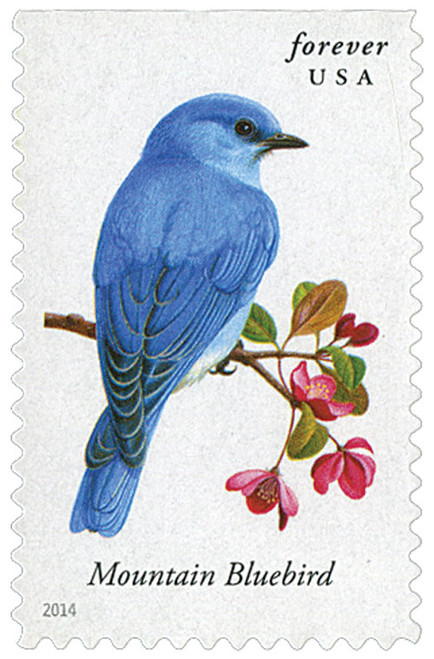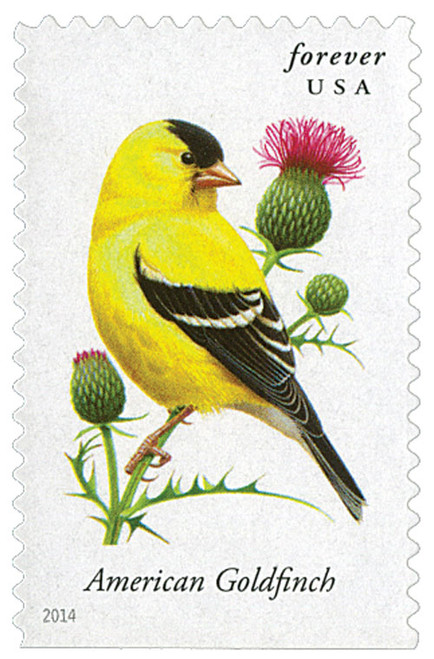
# 4889 - 2014 First-Class Forever Stamp - Songbirds: Rose-Breasted Grosbeak
US #4889
2014 Rose-Breasted Grosbeak – Songbirds
- Pictures a rose-breasted grosbeak
- One of 10 stamps picturing different species of songbird
Stamp Category: Commemorative
Set: Songbirds
Value: 49¢ First Class Mail Rate (Forever)
First Day of Issue: April 5, 2014
First Day City: Dallas, Texas
Quantity Issued: 400,000,000
Printed by: Ashton Potter (USA) Ltd.
Printing Method: Offset
Format: Double-sided Booklets of 20
Tagging: Nonphosphored Type III, Overall Tagged
Why the stamp was issued: To commemorate the rose-breasted grosbeak and its unique song.
About the stamp design: Pictures a painting of a rose-breasted grosbeak perched on a branch with pink flowers. Artwork by Robert Giusti. The stamp also includes the species’ common name.
First Day City: In addition to the Dallas, Texas, First Day of Issue city, there was also a First Day of Sale ceremony held at the Philadelphia National Stamp Exposition in Oaks, Pennsylvania. They offered two different pictorial postmarks: one from Oaks and one from nearby Audubon, Pennsylvania. The pictorial cancels were designed by the American First Day Cover Society.
About the Songbirds set: Issued to commemorate the many species of songbirds that call America home and fill the air with the sounds of their unique tunes. Includes 10 different designs, each picturing a different species of songbird and its’ common name: western meadowlark, mountain bluebird, western tanager, painted bunting, Baltimore oriole, evening grosbeak, scarlet tanager, rose-breasted grosbeak, American goldfinch, and white-throated sparrow. In addition to the birds themselves, the stamps also picture different plants (often found in the birds’ natural habitats) acting as perches. Designs were created from paintings by Robert Giusti.
History the stamp represents: Each spring, the rose-breasted grosbeak begins its migration from parts of Mexico, Central America, and South America. A long-distance traveler, this grosbeak journeys all the way to the young forests of the northeastern United States and Canada.
Upon arrival at the breeding territory, the male grosbeak, like many songbirds, serenades prospective mates and performs an elaborate courtship display. The pair then builds their nest together, taking turns incubating the eggs and feeding the hatchlings. Throughout the season, they will continuously sing to each other, even when sitting in the nest and during the nighttime hours.
While the male grosbeak is easily recognized for the bright red chevron, or “V,” set stark against his white breast during the spring and summer months, he and his female counterpart are best known for their remarkable songs.
The rose-breasted grosbeak whistles sweet songs lasting up to six seconds and consisting of multiple notes that rise and fall harmoniously. In the early 20th century, naturalists remarked that its song “has been compared with the finest efforts of the robin… and the scarlet tanager, but is far superior to either.” Some even say that the rose-breasted grosbeak sounds like an American robin that has had opera training.
US #4889
2014 Rose-Breasted Grosbeak – Songbirds
- Pictures a rose-breasted grosbeak
- One of 10 stamps picturing different species of songbird
Stamp Category: Commemorative
Set: Songbirds
Value: 49¢ First Class Mail Rate (Forever)
First Day of Issue: April 5, 2014
First Day City: Dallas, Texas
Quantity Issued: 400,000,000
Printed by: Ashton Potter (USA) Ltd.
Printing Method: Offset
Format: Double-sided Booklets of 20
Tagging: Nonphosphored Type III, Overall Tagged
Why the stamp was issued: To commemorate the rose-breasted grosbeak and its unique song.
About the stamp design: Pictures a painting of a rose-breasted grosbeak perched on a branch with pink flowers. Artwork by Robert Giusti. The stamp also includes the species’ common name.
First Day City: In addition to the Dallas, Texas, First Day of Issue city, there was also a First Day of Sale ceremony held at the Philadelphia National Stamp Exposition in Oaks, Pennsylvania. They offered two different pictorial postmarks: one from Oaks and one from nearby Audubon, Pennsylvania. The pictorial cancels were designed by the American First Day Cover Society.
About the Songbirds set: Issued to commemorate the many species of songbirds that call America home and fill the air with the sounds of their unique tunes. Includes 10 different designs, each picturing a different species of songbird and its’ common name: western meadowlark, mountain bluebird, western tanager, painted bunting, Baltimore oriole, evening grosbeak, scarlet tanager, rose-breasted grosbeak, American goldfinch, and white-throated sparrow. In addition to the birds themselves, the stamps also picture different plants (often found in the birds’ natural habitats) acting as perches. Designs were created from paintings by Robert Giusti.
History the stamp represents: Each spring, the rose-breasted grosbeak begins its migration from parts of Mexico, Central America, and South America. A long-distance traveler, this grosbeak journeys all the way to the young forests of the northeastern United States and Canada.
Upon arrival at the breeding territory, the male grosbeak, like many songbirds, serenades prospective mates and performs an elaborate courtship display. The pair then builds their nest together, taking turns incubating the eggs and feeding the hatchlings. Throughout the season, they will continuously sing to each other, even when sitting in the nest and during the nighttime hours.
While the male grosbeak is easily recognized for the bright red chevron, or “V,” set stark against his white breast during the spring and summer months, he and his female counterpart are best known for their remarkable songs.
The rose-breasted grosbeak whistles sweet songs lasting up to six seconds and consisting of multiple notes that rise and fall harmoniously. In the early 20th century, naturalists remarked that its song “has been compared with the finest efforts of the robin… and the scarlet tanager, but is far superior to either.” Some even say that the rose-breasted grosbeak sounds like an American robin that has had opera training.














